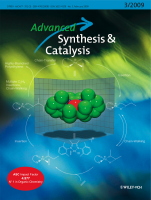"Homobimetallic Ruthenium Vinylidene Allenylidene, and Indenylidene Complexes: Synthesis, Characterization, and Catalytic Studies"
Xavier Sauvage, Yannick Borguet, Guillermo Zaragoza, Albert Demonceau, and Lionel Delaude
 |
source: Advanced Synthesis & Catalysis
year: 2009
volume: 351
first page: 441
last page: 455
doi: 10.1002/adsc.200800664
|

Abstract: Four homobimetallic ruthenium-(p-cymene) complexes bearing a tricyclohexylphosphine ligand and polyunsaturated carbon-rich fragments were obtained via a vinylidene-allenylidene-indenylidene cascade pathway from the ethylene complex [(p-cymene)Ru(μ-Cl)3RuCl(PCy3(η2-C2H4)] (7a). All the products were isolated and fully characterized by IR and NMR spectroscopies. The molecular structure of the indenylidene complex 11 was determined by X-ray crystallographic analysis. The catalytic activity of the four complexes was probed in various types of olefin metathesis reactions and compared with those of a related homobimetallic ruthenium-benzylidene complex, as well as first, second, and third generation monometallic Grubbs catalysts. In the ring-closing metathesis (RCM) of diethyl diallylmalonate, the homobimetallic ruthenium-indenylidene complex 11 outperformed all the ruthenium-benzylidene complexes under investigation and was only slightly less efficient than its monometallic parent. Cross-metathesis experiments with ethylene showed that deactivation of ruthenium-benzylidene or indenylidene complexes was due to the rapid bimolecular decomposition of methylidene active species into ethylene complex 7a. Vinylidene and allenylidene complexes were far less efficient catalyst precursors for ring-opening metathesis polymerization (ROMP) or RCM and remained inert under an ethylene atmosphere. Their catalytic activity was, however, substantially enhanced upon addition of an acidic co-catalyst that most likely promoted their in situ transformation into indenylidene species. Due to its straightforward synthesis and high metathetical activity, homobimetallic ruthenium-indenylidene complex 11 is a valuable intermediate for the preparation of the Hoveyda-Grubbs catalyst [Cl2Ru(PCy3)(=CH-o-O-i-PrC6H4)] via stoichiometric cross-metathesis with 2-isopropoxystyrene. The procedure did not require any sacrificial phosphine and the transition metal not incorporated into the final product was easily recovered and recycled at the end of the process.
Keywords: Alkenes, Arene Ligands, Bridging Ligands, Catalyst Design, Metathesis, Propargylic Alcohols
[Full Text] [<< Previous Article] [Back to the List of Publications] [Next Article >>] l.delaude@ulg.ac.be